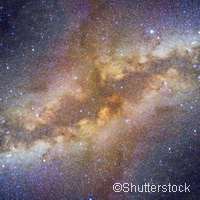
The discovery, made by researchers from the Centre national de la recherche scientifique (CNRS) and the Atomic Energy and Alternative Energies Commission (CEA), was made possible thanks to the European X-ray astronomy satellite XMM-Newton. This satellite is also unique as it is the biggest scientific satellite ever built in Europe; its telescope mirrors are among the most powerful ever developed in the world, and with its sensitive cameras it can see much more than any previous X-ray satellite.
Cosmic rays were discovered by the Austrian physicist Victor Franz Hess 100 years ago when he noticed the existence of ionising radiation of extraterrestrial origin. When certain stars at the end of their lives explode and become supernovae, their matter is ejected at supersonic speed, generating shock waves that accelerate the particles. As a result, some atomic nuclei gain very high kinetic energy and enter the Earth’s atmosphere.
Low-energy cosmic rays – which are rays whose kinetic energy is less than half a billion electronvolts – are not easily detected in the region of our planet since the solar wind prevents them from entering our heliosphere. As a result, little is known about their chemical composition and flux outside the Solar System, although everything suggests they play a significant role in the Galaxy. For example, it has been suggested that by ionizing and heating the densest interstellar clouds they probably regulate the formation of stars.
The astronomers began their research by studying the X-ray emission that should theoretically be generated by low-energy cosmic rays in the interstellar medium. They then looked for signs of this theoretical emission in X-ray data collected by XMM-Newton since its launch in 1999. By analysing the properties of the X-ray emission of interstellar iron recorded by the satellite, they found the signatures of a large fast ion population in the vicinity of the Arches cluster, about one hundred light years from the centre of the Milky Way. The astronomers estimate that the stars in this cluster are traveling together at a speed of approximately 700 000 km/h. The cosmic rays are in all likelihood produced in the high-speed collision of the star cluster with a gas cloud in its path. In this particular region, the energy density of the accelerated ions is around 1 000 times greater than that of cosmic rays in the neighbourhood of the Solar System.
What makes this research stand out is that this is the first time that a major source of low-energy cosmic rays has been discovered outside the Solar System. It shows that the shock waves of supernovae are not the only objects that can cause mass acceleration of atomic nuclei in the Galaxy. As a result of these findings it should now be possible to identify new sources of ions in the interstellar medium, which may lead to a better understanding of the effects of these energetic particles on star formation.
Contacts and sources:
A new discovery proving the earth and the universe is changing
ReplyDeleteSUPPORT!
ReplyDeleteThis discovery of the new cosmic ray is really amazing. just wonder whether it is come from Planet x :p
ReplyDeletethx
ReplyDeleteThe discovery is quite shocking...never heard that before.
ReplyDeletethanks for sharing!
ReplyDeleteSUPPORT!
ReplyDeletethanks for sharing!
ReplyDelete